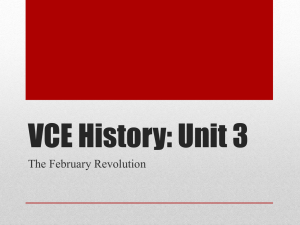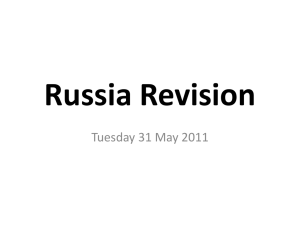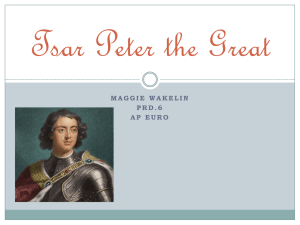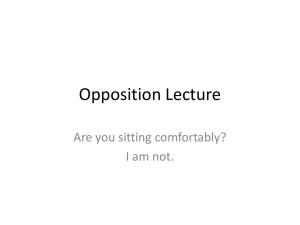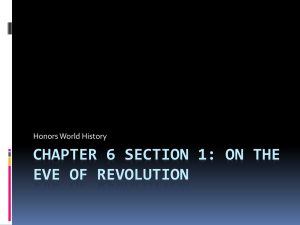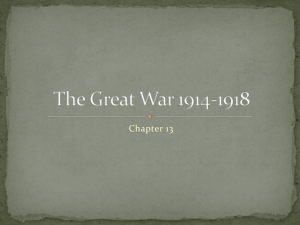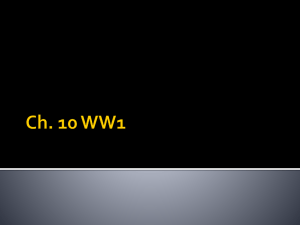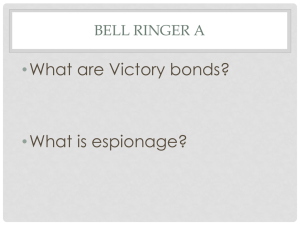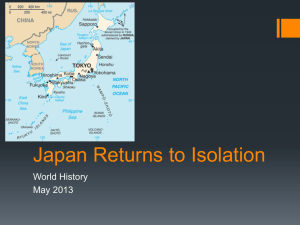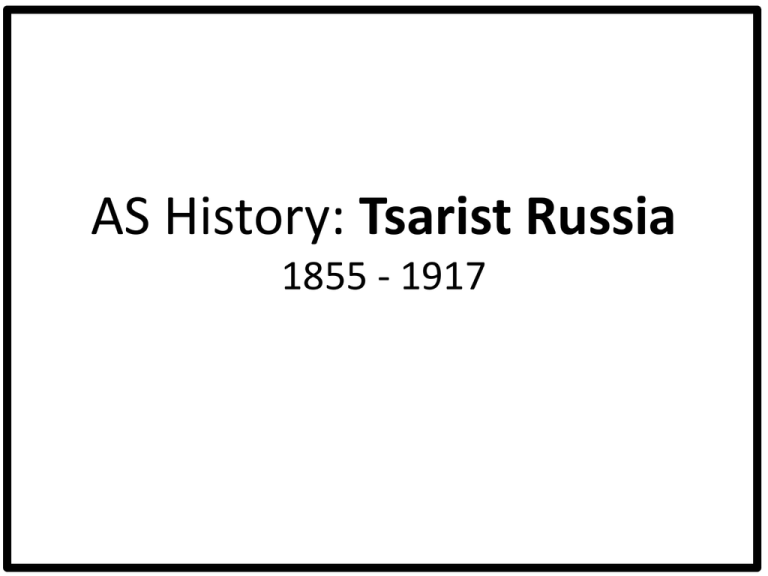
AS History: Tsarist Russia
1855 - 1917
Why was Russia Backwards?
Political
Autocracy
No opposition/ other
political parties
Nobles in control
Secret police
Conscripted Army
Economic
Harsh winter –
affected farming
Backwards farming
methods
Banking
undeveloped
No consumer
demand for products
Poor
communications
Social
50 million serfs –
82% of the population
800,000 industrial
workers
No demand to
develop
Social hierarchy
Mostly of Russian
Orthodox religion
3500 people in 6
universities
Other Factors
Climate – frozen lakes, hard to import and trade on
Size of Russia – Extremely hard due to the poor communications
Alexander II 1855-1881
OVERVIEW
o Tsar liberator
o Failed to provide long term solutions
o Emancipation of the serfs 1861 - peasants were allowed to but land from
redemption payments to the state for 49years
o Established the zemstva; elected council, 40% voted by peasants
o Extended primary and secondary education
o Universities became autonomous and reduced class bias
o Increased criticism of Tsarism - peasants became indebted and led to rise
of populist revolutionary movements such as the People's Will
o Zemztva led to a desire for democracy
o Increased number of educated people
o Provided the potential for an organised party - not established till 20th
century
o Assassinated 1881 by People's Will
Alexander II 1855-1881
KEY DATES
1855 - Alexander II becomes Tsar
1861 – Emancipation of serfs
1863 – What is to be done? Published
1870-3 – Railway Mania years
1877 – Political trials of the populists who had “gone to the people”
March 1881 – Alexander II assassinated
Why did Alex Emancipate the Serfs?
Alex's own
Crimean
RUSSIAPolitical
NEEDED TO MODERNISE TOviews
REMAIN A GREAT POWER
AND War
BECOME
Would bring
Social
structure
did nothing
Turkey
– suffering a
MORE
WESTERNISED
– THIS COULD
ONLY HAPPENAgainst
THROUGH
EMANCIPATION
a
more
for the nobility
humiliating defeat.
dynamic
Nobles
income
andTOwere
Russia realised they had to
SERFDOM
HADfell
LEAD
economy
still dependent on serfs
develop and modernise
Serfdom
Had to get rid of conscription
oPrevention of labour market morally wrong
and serfdom
oNo need to modernise methods– western
Economic
view
374,600 deaths in total
oCrimean
war exposing Russia's backwardness
Nobles
forced
to take
outhad beenIn
order
for 1800)
oPeasant
revolts
(there
1467
before
mortgages
onabolish
previously
modernisation
Moral
+ Intellectual
o“Better to
from above, than
have it forced upon
us from
below.” –
to happen
owned
Nihilists- ?
Alex estates
serfs had to
Population doubled in the
Intelligentsia- wanted change
be
first
half
of TO
theCHANGE
century SERFDOM HAD TO BE ABOLISHED
Reform amongst intellectuals
FOR
THIS
emancipated
Russia needed to catch up
began 1?55 which divided
3rd March
and reassert its power
opinion on Russia becoming
1861
Would lead to more
more western
emancipation
productive peasants
signed and
They all suggested different
Plans to build a great rail.
published
methods
RUSSIA NEEDED TO MODERNISE TO REMAIN A GREAT POWER AND BECOME
MORE WESTERNISED – THIS COULD ONLY HAPPEN THROUGH EMANCIPATION
SERFDOM HAD LEAD TO-
oPrevention of labour market
oNo need to modernise methods
oCrimean war exposing Russia's backwardness
oPeasant revolts (there had been 1467 before 1800)
o“Better to abolish from above, than have it forced upon us from below.” –
Alex
FOR THIS TO CHANGE SERFDOM HAD TO BE ABOLISHED
How were the Serfs Emancipated?
Feb 1861
Serfs Freed - 40 million
Gains
Losses
A starting block for the
peasants?
In return from the peasants?
Peasants granted land and
property
Rights to marry, travel and set up
businesses
Compensation?
To land owners that lost out
Compensation often much higher
than the land that was taken was
actually worth
Peasants to pay redemption
payments for 49 years
These had a high - 6% interest
Payments often grater than land
value
Had to stay within commune until
all payments made.
However?
•Peasants had to wait two years
•State peasants 5 years
What were the problems
with Emancipation?
Peasants had less land – often infertile and scattered
Peasants paid more tax – so high that they had to sell all their grain, leaving nothing
for them to survive on
Little changed – peasants still tied to land and Mir and still used traditional farming
methods
Household serfs who had no agricultural skills had to find other employment which
often wasn't very well paid or productive – only gained freedom and no land
Landlords paid off debts – did not invest in the economy
248 out of 543million roubles paid to land lords as compensation was used to pay off debts
Russia remained backwards – ‘new type of slavery’
What was the impact of Alexander II’s other
Military
Education
reforms?
Action Taken
Lowered
Judicial
Local
Gov. Development
Economic
conscription to
Action Taken
Action Taken
6years (was 25)
Local courts set
System of elected
Tsar tried to modernise Russia by:
up
local councils
Improved
oEmancipation
Made fairer
Electoral collages
training
oRailways
system
Positives
Humane
oBanks
Positives
Zhemstva (filled
discipline
Equality
voids from
More efficient
He acheieved:
established – more
emancipation), had
Positives
chance of a fair
a range of powers
o13,000 line of railway
Not forced to
trial - juries
to make
oBuilding blocks on the
way to modernisation
join
Less judges giving
improvements e.g.
Military
into black mail
To roads
But failed at:
advanced
Negatives
oModernising RussiaNegatives
as it still lagged behind
western Russia
Negatives
Little chance of
Votes – so nobility
oPeople not totally freed
justice
kept dominant
Serfs unable to
oTime scale – too slow
No questioning
Democracy not
get higher ranks
Everyone
achieved.
Higher classes
presumed guilty
Short on money
dominated
Action Taken
Funded
educational
institutions
Positives
Schools open to all
regardless of sex or
class.
Aimed to help
catch up with
western
modernised
countries
Curriculum
Inspectors
More poor and
women in unis
Negatives
Radical an militant
thinkers increased/
revolutionary ideas
Economic Development
Tsar tried to modernise Russia by:
oEmancipation
oRailways
oBanks
He acheieved:
o13,000 line of railway
oBuilding blocks on the way to modernisation
But failed at:
oModernising Russia as it still lagged behind western Russia
oPeople not totally freed
oTime scale – too slow
Why did his reforms come to an end?
April 1866 – Assassination attempt
Personal life – Affair and death of son – retreated from political life
Criticisms – Slavophiles “gone too far” – westernises “not far enough”
More Conservative ministers appointed
Increased radical demands and revolutionary activity
Polish Revolt – He saw it as ingratitude and pointlessness to further reform
What was the extent of the reaction up to
1881?
Education
Increased censorship over universitys
Increased restrictions on entry requirements (prevent lower classes getting in)
Press
Used to attack critics of government
Sentencing
Harsher sentences in jail or exile
Separate political trials
Violence and opposition still grew
Alexander assassinated by the peoples will.
How significant was opposition to Tsarism
up to 1881?
Why did opposition grow from the 1960s?
Alexander II’s reforms raised expectations
Discontent amongst higher classes – Nobles, landlords
Better to reform from above, than have a reform from below
Failure to fulfil expectations of reforms
Right win opposition
Students studied abroad and returned with new ideas
Less censorship meant new ideas new ideas (and criticisms) spread quickly
Marxism
Populism – made the government aware of the strong feelings – loss of authority
and direction
Intellectuals like Herzen and Chernyshevsky (what is to be done?) were
influential
What type of radical opposition was there in
the 1860s and 1870s?
Populism
Students
Persuade peasants to revolt
“going to the people”- dressed
up
3000 went to the countryside
Win over with socialists ideas
But peasants were ignorant and
ignored them
Land and liberty emerged from
this – more radical and better
organised -violence
Black partition
Tried to persuade peasants to
revolt
Propaganda without having to
use violence
The peoples will
From land and liberty
Used direct violence –terrorism
Against gov. in attempt to spark revolution
Tsar had to be removed
Did not use real names – Okrana
37 members + Mikhailov - leader
Before the assassination the group had
made 8 attempts to kill him.
Attempts mostly failed – for example
blowing up the wrong train
Big threat to Tsardom
Resulted in political trials – 5 hanged, 2
executed, 1 life imprisonment, 1 reduced to
20 yrs
Two break off groups Younger peoples will +
the other; Terrorism Section (killed Alex III)
Why did terrorism fail to destroy Tsarism?
The terrorists failed to gain enough support
Terrorists offered no alternative form of government
Conservatives continued to support the Tsar rather than radicals
Alexander III 1881-1894
OVERVIEW
o Period of successful repression
o Crushed revolutionaries in the short term
o Economic change from Witte and the great spurt
o Utilised emergency powers
o Created the Okhrana
o Increased censorship
o Created land captains
o Increased government interference in laws
o Restricted the zemstva and education
o Period of Russification
o Supported industrialisation - 8% increase per anum
o Exploited agriculture as a form of income from exports
o Created stability for autocracy
o He predicted 1905 revolution from the growth of urban and rural unrest
Alexander III 1881-1894
KEY DATES
March 1881 – Alexander III becomes Tsar
1885 – Peasant land banks
1891-2 – Russia's worst famine of the 19th century
1892 – Witte takes over from Vyshnegradsky
1894 – Nicholas becomes Tsar
Vyshenegradsky and Witte
Vyshenegradsky
Finance minister 18871892
Trans Siberian rail and
tariffs
Stronger gov
interference
Increased tax (on
peasants) and pushed for
exportation of goods
Balanced budget deficit
1891-1892 famine
Witte
Finance minister – 1893
Highly influential – extensive industrialisation
Oversaw construction of railway
Economic growth
Foreign investments encouraged
Gold standard
Committed to industrialisation – driving force
Economic development only way to raise living
standards
If everyone prospered then no call for revolution
Identified key problems – insufficient capital,
lack of expertise, no manpower
Why did the government encourage
Economic Development
Economic strength =
military strength
Able to produce more
weapons to protect
Russia
Industrial growth
For higher wages
Employment
Cheaper goods
Would guard against
social unrest
Couldn't compete
with other European
countries who had
experienced industrial
revolution
Had resources but
couldn't use them
efficiently because of a
lack of industry
Emancipation
failed to stimulate
agricultural
development
Russia still backwards
Would create more
jobs for freed serfs
What policies were introduced?
Protective
Tariffs
Foreign
investment
1880 – 98
million roubles
1900 – 911
million roubles
Peasants land
bank
Peasant Poll
Tax abolished
Make Russian
currency
Stable
Expansion of
the Railway
System
1900 – 53,000
km
1840 – 27 km
of railway
Advice
Foreign experts
and workers
encouraged to
advise on
planning and
techniques
Taxes raised
What were the effects of the policies? Positives
Economy expansion
1900 – expanding at 8%
per annum
Russia 4th largest
economy
Exploitation of Russia's
raw materials
New industrial ideas
Growth in foreign
Trade
However exports mainly
agricultural
Transport – steamboats train
Classes
Urbanisation –
working classes
reached aprox. 11
million
What were the effects of the policies? Negatives
Poor living and working conditions
Slums, over crowding, pollution, poor health
1904 – 1/3 of houses in st Petersburg had houses with water
Low wages and unsecure employment
1899 Russia affected by world depression
Church
Influence of Orthodox church weakened – peasants moved to cities
Workers vulnerable to revolutionary propaganda
Heavy spending on military
1885 onwards – 50% of government spending on military
Middle class and workers grew
Denied political voice
What were the effects of the policies on the
rural economy
Grain exports increased
Low income
Famine -1891 – peasants
2 million died of starvation, also
outbreaks of typhus and cholera
Gov criticised by liberals and radicals
Vyshenegradshy – “we shall not eat but
we shall export”
Land bank
Peasants purchased 1/3 of landlords
estates
Increased debt and taxes
American farms 1.5 that of Russia and
Britain 4 times greater
Taxes raised so peasants sold
more grain to survive
Backwards methods remained
Land hunger – mir still active
Poor yields
Other
Improvements in healthcare
¾ able to do scheme – 97 million
Didn't deal with strain of growing
population
Unfit for military service
IMR – 57.4%
LE – 27 men – 30 women
England's 46
Peasants affected negatively
What type of opposition and ideas emerged
from the 1880s?
Middle class and workforce
Potential opponents
Intellectuals
Criticises Tsarism
Zemstva
Demanded more powers
Marxism
Intellectuals support – revolution
from the workers not peasants
Vision of economic and industrial
growth
Workers key to power
Liberals (mainly middle class)
Wanted modernisation – more westernised
1904 union of liberation formed– demanded democracy
Russian Social democratic labour party
Believed in Marxism – split into:
Bolsheviks – Small, sieze power ASAP
Mensheviks – Spread propaganda – not to lead to revolution
Socialist revolutionary party (was populist)
Terrorism and reform from below (peasants) – little support
Why did radical opposition emerge?
Marxism
New radical ideas
Social effects of industrialisation
Urbanisation
More industrial workers
Growing middle classes
Reactionary policies of Alexander
III and chief minister Chief
Minister Pobedonostsev
Famine 1891-92
Combating opposition – Secret police
Okhrana
Intrusive
Find revolutionary activity
Communists, socialists, trade unions etc..
Torturing, executions and exile
What were the reactionary policies?
Harsher Sentencing
Special courts set up to try political offences
Lberal judges removed
Gov direct control over police
Severe prison conditions
Land captains appointed by Tsarist gov
Control courts, and local gov (Zemstva)
Russification – forced to learn language and culture
Discrimination and Anti-Semitism
5million Jews blamed for Russia's problems
University fees raised
Tougher requirements and censorship
Peasant representation in Zemstva reduced
Lower classes got secondary education
What reforms were introduced, 1881 –
1904?
Employment of
children under 12
banned
Female workers in
mines were banned
Factory inspections
Peasant land bank
Introduction of 11
½ hour days
Largely ignored
Allowed to buy land
from land lords
Peasants poll tax
abolished
Part I
Nicholas II 1894-1917
OVERVIEW
o Did not want to be Tsar
o Unprepared
o Autocratic
o Believed in the Divine Right from tutor Pobedonstev
o Saw reform as a "senseless dream“
o Continued repression - extended Russification.
o Could not maintain the regime
o Zemstva grew in power and strikes increased
o Peasant discontent grew from tax burden
o Land hunger resulted from an increase in population
o Loss of Russo-Japanese war
o Disorganised 1905 revolution which was ended by the weakness of
opposition and government concessions
Nicholas II 1894-1917
(Part I - 1894-1906)
KEY DATES
1894 – Nicholas II becomes Tsar
1902-5 – series of peasant uprisings
1903 – Worst wave of anti Semitic pogroms
1904-5 – Russo-Japanese war
Jan 1905 – Bloody Sunday
October 1905 – October manifesto
March 1906 – Fundamental laws
Why did war with Japan break out in 1904-5?
Land Disputes
Japan believed Russia
wanted to gain land in
the far east
They had disputes over
Korea and Manchuria
Japan attacks
Japanese attacked the
Russian fleet of port
Arthur
Under estimation
Russians believed
they would win
War would deflect
attention from
domestic problems
What were the consequences of the war?
Beginning
Military
Result to Russia
Early patriotism and
support of the Tsar
War was a distraction
from domestic problems
Army defeat in 1904
and 05
Total destruction of
Russia's main fleet in
May 1905 added to the
revolutionary process
Humiliation
Forced to negotiate a
peace treaty (Treaty of
Portsmouth) and lost
influence in the far east
What incidents followed Bloody Sunday?
How did the 1905 Revolution start? Bloody SundayJan 1905
Demonstration lead by Father Gapon
They demanded:
8hour working day
Elected assembly
Freedom of speech
150,000 protestors fired on by soldiers in front of Tsars winter palace
Up to 200 deaths 800 wounded
As a result...
General strikes swept across Russia, Jan-Feb 1905 – 400,000 strikers
Union of unions formed – demanded reform
Sailors on the Potemkin Battleship mutinied – Putilov Plant strikes
All Russian Peasants union – demanded land reform
Railway Strike – turned into general strike – 2.7 million
Constitutional democratic Party formed – Kadets
Soviet set up – workers council
Workers in Moscow set up baracades – fighting with police and soldiers
Peasant uprisings spread – 3000. – land lords houses property runined
Why did Revolution occur in 1905?
Political
Revolutionary groups encouraged action against Tsarism – change
only through revolution (SRs)
Military defeat with Japan – humiliation
Repression by gov – secret police and censorship
Disillusionment of middle class who were denied political outlet
Nationalism – non Russians angry at policies towards them
(Russification)
TRIGGER
Bloody
Sunday
9th/22nd
Jan 1905
Social
Economic
Poor living conditions
Poor working conditions
Peasants discontent
War left food shortage, high
prices and unemployment
Economic Slump – job loss
Poor harvests – starvation, disease, civil unrest
Population expansion lead to pressure on
resources
Wittes reforms affected the least paid the most
– had to work in bad conditions, low wages and
high tax
Peasants – tax and redemption payments
What reforms did Nicholas allow and
promise in response to the revolution?
Government
Nicholas accepted cabinet
government and appointed
Witte as his first prime minister
Had warned on verge of
revolution
October Manifesto
Peasants
Redemption
It Promised
payments cancelled
Elected State Duma
Freedom of Assembly
Freedom of press
The Fundamental
Freedom of speech
Russian people reaction
Celebration – on streets of St Petersburg – sang, waved flags
And the opposition?
United at start of 1905 - Divided by end of 1905
Liberals accepted
St Petersburg soviet called general strike – not
supported by workers and middle class
General strike called off – birth of new Russia
Trotsky and Lenin – granted constitution yet autocracy
remains – granted everything yet granted nothing
Laws
Legislative power
with Duma and council
of empire
Tsar approves laws –
without, a law cannot
exist
Tsar can appoint and
dismiss the president
of the Duma
Tsar can abolish
Duma
What means of repression did Nicholas and
Stolypin use?
Petersburg soviet closed
down
Uprising and Violence
Moscow uprising was
bloodily put down
Over 1000 workers died –
two weeks of street fighting
Death penalty
Use of death penalty
5000 death sentences
between 1907-09
Laws
Fundamental
laws
Tsar issued
Limited Duma
power
Tsar ultimate
authority
Martial law
declared
Opposition
Arrests of opponents
200,000 political
prisoners – 1908
1912 – Lena Goldfields
massacre
200 strikers killed by
soldiers
Strike for working
conditions and living
conditions
Caused widespread
disgust – but not
revolution
Part II
Nicholas II 1905-1917
OVERVIEW
o Reforming concessions under the influence of Witte
o End of peasant debt
o October manifesto - creation of Duma (parliament) which pulled the
Liberal movements suit
o Fundamental laws 1906 - limited legislative power of the Duma
o Stolypin's restrictions made the Duma supportive of the Tsar
o The first agrarian reforms created by Stolypin - the Stolypin system
Nicholas II 1894-1917
(Part II – 1906 - 1917)
KEY DATES
May 1906 – Meeting of the First Duma
1907 – Cancellation of redemption payments
April 1912 – Lena Goldfields massacre
August 1914 – Russia enters FWW
1915-16 – “ministerial leapfrogging” – changing ministers
18th Feb – 3rd March – February revolution
How did the Dumas operate?
1st Duma – National hopes
April – June 1906
30% workers/peasents
Majority of SRs, Bolsheviks Mensheviks,
Octoberists etc.
Wanted: everyone to have a vote, Land
reforms, Trade union rights, Release political
prisoners
These were all rejected by Tsar
Dissolved by Tsar – too radical and demanding
3rd Duma – Lords and Lackeys
3rd
Nov 1907 – 1912
Agreed 2000-2500 gov proposals
Disputes
By the end not working – no control
More representation of nobility
Opposition parties (Bols..) now
outnumbered by reactionaries and nationalists
2nd Duma – National anger
Feb – June 1907
Governments attempts to interfere
with elections
Dissolved by Tsar after refusing to
expel social democratic deputies
Liberal members reduced and left
wingers increased
Stolypin dissolved – wanted to
change voting system exclude large
number voting
4th Duma
November 1912- August 1917
Rift between left and right
Number of radicals increased
Duma ignored
Workers took initiative –strike
activity and direct action
What agrarian reforms were introduced by
Stolypin?
Aims
Goal to transform traditional agriculture
Abolish communal system
Aimed to create a new type of peasant class
“Wager on the strong and sober” - Stolypin
Success
Immediate impact
15% of the peasantry took up new
opportunities
1914 – 25% left communes
10% consolidated their holdings
Land banks set up to help
peasants become owners
1907 – redemption payments
abolished
Nobility support – revolution less
likely
Limitations
Not total success
After initial rush applications to leave
and consolidate declined
Stolypins peasants became more
prosperous (ones who took advantage)
14% of communal land passed onto
private ownership
Strip farming carried on and wouldn't
give up security of the mir
Couldn't build large farms
Poor and landless peasants - alienated
What was the condition of Russia in 1914?
Positives
Some increasingly prosperous peasants
Rapidly growing industry
Improving working and living conditions for
some – high inflation, no real improvement
in their living standards 1905-14
Peasants became richer, gained freedom to
buy land, travel and more independence
(peasants)
Health service, education, wages (workers)
Professional job expansion, support
conservative outlook (middle class)
Stolypins necktie, 3,000 hung, military
courts, repression – okrana, Duma (less
political opposition)
Banks, oil (second to Texas) 100% increase
in production, coal increase – fourth largest
(economic growth)
Duma succeeds in land reform, autocrat
evolution, loyalty (stability)
Negatives
Industry still small and inefficient
Agricultural production remained low
Repression did not get rid of
opposition –opposition went
underground
4/5 still peasants, 60% illiterate, Serbia
land taken, increase gap between rich
and poor – gained little from boom
(peasants)
No trade unions, grim conditions, low
education, 1912-14 3mill involved in
strike, inflation, Lena goldfields(wk)
Minority, growth in rev. Ideas –
Marxism, Bolsheviks etc. (M/class)
inflation, unstable econ,
communications not passed
on(economic growth)
Duma-lack of power + abollished,
fundamental laws, unfair trials, Tsar
threat (stability)
How had Russia developed economically by
1914?
Developed
Undeveloped
Exports growing
Economy growing 8.8% per year –
more than western rivals
5th largest industrial power
Expanded enterprises
State money into heavy industry
4th largest coal producer
Neglect light industry – grew with
consumer demand
State revenue doubled – 4bil roubles
2393 banks by 1914
Factories rise – 2300
Extension of health services
1912- health insurance estab.
10years compulsory education -77%
growth in pupils
1914 – 40% literacy rate increase
Industry only employed 5% of
population
Population explosion – crisis in
agriculture and poor working/living
conditions
Regime still reliant on depression
No trade unions or legal protection
At mercy of employers
Wages rose but so did inflation -40%
Some areas better than others
Conditions grim
Low levels of education
Lena goldfields
3 million workers invloved in strike
activity
4/5 Russian pop. Still peasants – lack
of development
Why was Tsarism able to survive up to 1914?
Decline in support for revolutionary
groups
Repression of revolutionary groups –
authorities successful, secret police
infiltration – Lenin, SRs etc. Exiled
1444 people hung in 1907
Arrests and speady trials
3000 suspects convicted and
executed
Groups divided –RSDLP into Bolsheviks
and Mensheviks
Loss of support – dropped from 150,000
in 1905 to 10,000 in 1914
4th Duma only 13 seats
Most wanted to get on with the difficult
task of living
SR’s – not clear how they would bring
change
Growing support for the
government
Governmental reforms
Education
taxation
Stolypin worked with 3rd and
4th Dumas – changed electoral
system, co-operation with the
Tsars government - more willing
Liberals (octoberists/kadets) –
to work with Tsars government
Advance in industrialisation
and economic growth
Increased workers standard of
living
Situation in March 1917
Tsars actions
Not listen to reform, close duma, reassert authority by joining front line
Social and Economic discontent
Only 9% of Russia mobilised
-Women and children took over work
People in army relieved pop. Pressures
-produce less goods
Royal Family
Unpopular – blamed military failings on Nic
-Dislike Tsarina- German spy?
Final straw to let Rasputin and Tsarina take over – lost support and nobility support
Liberal opposition
Unsuccessful Duma – overruled and abolished
Split, radical action and compromised
Armed forces
Poorly equipped
Conscription
- Refused orders – don’t remain loyal
War
Early patriotism
High deaths
-food shortage
-opposition
(similar to 1905 revolution but larger scale)
Tsar Abdication
Railway workers refused Tsar entrance to Petrograd –Tsar abdicates and exiled -Siberia
Army takes side
Feb – army refuse to obey orders – some shot officers and joined demonstrations
Revolution begins
International woman's day- Tsar order to use force
Putliov works strike in Petrograd – 40,000
Loss of support
Middle classes wanted a greater say
Resentment towards Tsarina and Rasputin
Harsh winters of 1916
Tsar goes to front line
Personal responsibility – Tsarina and Rasputin left to run country
Effects of war at home
Food and fuel shortage
Inflation
- prohibition
-unemployment
The effects of war
Deafeats at Tannenberg + Masurian lakes
1 million+ casualties or prisoners of war by 1914
IN DEATAIL – Masurian Lakes and Tannenberg
Masurian lake and Tannenberg battles:
oSuffered humiliating defeats
o1 million losses and casualties
oLarge majority of the killed were inexperienced soldiers
oDrop in moral
oLow intake
oDesertion and mutinies
oNot properly equipped – clothing, two riffles between three
oCommunication problems
oNic II went to front line – questioning of Tsars capability – personally
responsible
oMobilised 15million men between 1914 and 1917 – Positive
oBegan to make 10,000 riffles a month - Positive
Provisional Government 1917+
OVERVIEW
oSometimes known as the "Kerensky Government" after its leader.
oIt lasted approximately eight months
oLed by socialist Alexander Kerensky, a prominent member of the Duma
and a leader of the movement to unseat the Tsar.
oThe Provisional Government was unable to make decisive policy decisions
oThis weakness left the government open to strong challenges from both
the right and the left.
oThe period of competition for authority ended in late October 1917
oBolsheviks routed the ministers of the Provisional Government in the
events known as the October Revolution
oThey then placed power in the hands of the soviets, or "workers
councils," which they largely controlled.
Provisional Government 1917+
KEY DATES
27th Feb 1917 – First meeting of Petrograd soviet (workers, sailors etc.)
27th Feb 1917 – Provisional Government established
3rd April 1917 – Lenins return
3rd-6th July 1917 – the July Days
August 1917 – Kornilov revolt
24th Oct 1917 – Members of the red guard seize key points in Petrograd
What was the impact of the FWW - Military
Defeats
Only 8.8% mobilised
Compared to
Germanys 20.5%
Lacked equipment and
admin
Within first two
years met demands
- but after huge
shortages
Lacked equipment and
admin
Food shortages
Attitude turned to
pessimism and
defeatism
Losses
1.6 million deaths by
1917
3.9 million wounded
2.4 million taken
prisoner
Mass mutinies
Faith in the Tsar
Lost as commander in
chief
Made the decision to
join and command the
Russian armed forces
Stone – some historians may have exaggerated Russia's
weakness in 1917
What was the impact of the FWW - Economic
Cost
Inflation
In three years meat
prices rose by 232%
1.5 billion roubles
spent on war
High taxation and
borrowing from
abroad gave Russia
the funds it needed
Wages were paid but
money was worthless
Transport/Food
Disruption of rails caused
massive food shortages
By 1914 Russia had 44,000
miles of railway
Huge pressures to transport
troops and food to front line
Food left to rot as the side
of rail – breakdowns
Petrograd and Moscow got
1/3rd of the food it needed
Hunger/famine reality of
war
Lack of resources for the
population
Fuel Shortages
The lack of coal
increase
Hugely affect
transport
Moscow and
Petrograd got
1/3rd of the fuel it
needed
What was the impact of the FWW - Politically
Loss in government support
Tsar devoted to autocracy
Tsars refusal to cooperate with nongov organisations – Zemstva, union
of town councils
Military zones – civilian authority
taken over in these areas
Zemstva and city authorities
became the Zemgor – focus of liberal
opposition
Zemgor
Help for war wounded Russians
Highlighted gov. Failures
Alternative to Tsarism?
Tsarina reputation damaged by
Rasputin’s influence over her
Tsarina German – spy?
Formation of progressive bloc
Kadets, octoberists, nationalists and
progressive industrialists
Liberal members of Dumas
Opposed Tsarism
Bloc to persuade Tsar to make
concessions – focal point of politic
resistance
Support for Radicals increase
Social revolutionaries,
Mensheviks
Bolsheviks
The February Revolution - 1917
International
Demonstrations
Demonstrations
Who supported
revolution?
Continued
and Grew
and spread
Women's Day +
intensified
Soldiers joined in
Attacked gov
Striking workers
Petrograd garrison refused to fire
oRevolution
buildings – Down
240,000
involvedwas spontaneous
at by
crowds
– as Nic
ordered
with the Tsar, Down
oIt was not planned
political
parties
Half actively supported
withoverturn”
the War
oSukhanov – “No one revolution
party was preparing for the great
Tsar refusal to
Tsar unable to return to
Generals convinced
Revolution occur?
form new Why did the February
Petrograd
Nic II to abdicate
Workers had railways torn
“Would help war
government at
oThe Long
war was overwhelming
up
effort” - Ruzsky
request
of Duma
oGovernment could not cope with the war
Provisional Gov formed
Included members of progressive bloc and Petrograd soviet
Who supported revolution?
oRevolution was spontaneous
oIt was not planned by political parties
oSukhanov – “No one party was preparing for the great overturn”
Why did the February Revolution occur?
oThe Long war was overwhelming
oGovernment could not cope with the war
What were the problems faced by the Provisional
Government, March-Oct 1917
The War
Land Redistribution
ContinuedGovernment
losses and desertions
Petrograd Soviet and Provisional
Provisional gov delayed this and refused
July (1917) offensive failed
Peasants began to seize land
to allies
July
1917 – 1,100 illegal
attacks by = formedLoyalty
oProvisional
government
from Kadet
and Octoberist
peasants on landlords property
members of the Duma
Food and Fuel shortages
Deserters returned home to claim their
Continued
land
in –
towns
cities
oSoviets = Workers, soldiers – 3000Especially
members
not and
dominated
by
one racial
party Affair
Kornilov
Dual Power
General Kornilov – march into
Between Pro gov and Petrograd soviet
Petrograd
(wanted
stricter joined
discipline)
oMay 1917
– Soviets
the Provisional
Needed soviets
Government
support to pass
Pro Gov armed workers
anything
Kerensky turned to Bolsheviks for
support to help defend
Continuingly growing opposition
Exploited the weakness of the gov
Bolsheviks grew – “peace, bread, land”
Had to rely on opposition to stay in
Kornilov Affair key to this
power
SR’s Bolsheviks and Mensheviks
Inspired by Marxism
Petrograd Soviet and Provisional Government
oProvisional government = formed from Kadet and Octoberist
members of the Duma
oSoviets = Workers, soldiers – 3000 members – not dominated by
one racial party
oMay 1917 – Soviets joined the Provisional Government
What were the problems faced by the Provisional
Government, March-Oct 1917
....Kornilov Affair in Detail
July days – series of demonstrations/strikes/protests
Exploited the provisional government as weak – having a lack of control over the
Russian people
Kornilov believed in stricter discipline of the Russian people to repress them
Believed he could take over and do a better job
For those who didn't comply harsher penalties or sent to front line
General Kornilov – march into Petrograd
Pro Gov armed workers
Kerensky turned to Bolsheviks for support to help defend
Exploited the weakness of the gov
Had to rely on opposition to stay in power
Then what?
Bolsheviks seized opportunity to organise workers red guards
Kerensky supplied with arms
Kerensky ordered Kornilov to surrender (was planning military dictatorship?)
Sept 1st – Kornilov and General arrested
Why were the Bolsheviks able to seize power?
The Pro
Gov
became
more
and
more
disliked
(previous
slide)
The
Bolsheviks
were
increasingly
popular
Majority party
in Petrograd
Lenin was a good
leader
April Thesis –
End to war
All power to the
soviets
Peace bread land
Kornilov affair showed
that Bolsheviks could
lead
Bolsheviks opposed the
provisional government
Not compromised
by their involvement
SR’s and
Mensheviks were
Trotsky’s (Bol)
organisation
helped them
‘seize the
moment’
He became
chairman of
soviet
Soldiers agreed
to give
Bolsheviks
weapons
How did the Bolsheviks seize power?
24th Oct 1917
– Bolsheviks
took up key
points in
Petrograd
Bridges
Post offices
Railways
Banks
Kerensky (pro
gov leader)
appealed for
help – but
none came
Lenin
announced
replacement
of the
Provisional
Government
Social
revolutionaries
and
Mensheviks
refused to
work with
Bolsheviks
So Bolsheviks
formed a
government
alone.
Revolution was a coup d’etat
- blow state



